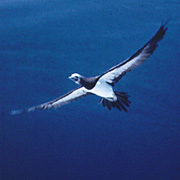Brown Booby
Sula
leucogaster
Pelecaniformes
These birds are aquatic, medium-sized to large, and feed on small fish and other animals found in the water. One of their most distinctive features is their feet, which have webbing between all four toes. Many have an unfeathered and sometimes brightly colored pouch of varying size at the throat. Most nest in colonies. Representatives of five of the order's six families have been found in Washington:
Sulidae
Boobies and gannets are large seabirds with long, heavy, pointed wings and long tails. Most have light-colored underparts and darker upperparts. Many members of this group are white. They are strong flyers, alternating between powerful wing beats and long glides. Most are sociable, nesting in colonies and foraging in flocks. They eat fish, squid, and other aquatic creatures, which they catch with spectacular plunge-dives. Their eyes are set forward on their heads, and this gives them binocular vision that aids them in foraging. When they plunge into the water, they use their wings to swim. They begin breeding at two to six years. Gannets and boobies are monogamous, and often form long-term pair bonds. Males bring nest material, and females build the nests. Both members of the pair help incubate the young by tucking one to three eggs under their webbed feet. Incubation lasts up to eight weeks, and the parents alternate in three-day shifts. Some species do not fledge until they are almost six months old, and are commonly dependent on both parents for up to nine months after that. Boobies are found in tropical waters, while gannets can be found in more temperate seas.
General Description
One bird seen at Protection Island for several days in October 1997.



